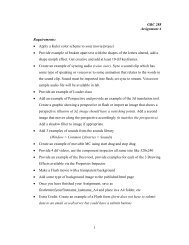Introducing Financial Accounting - CCSN Computer Graphics Program
Introducing Financial Accounting - CCSN Computer Graphics Program
Introducing Financial Accounting - CCSN Computer Graphics Program
You also want an ePaper? Increase the reach of your titles
YUMPU automatically turns print PDFs into web optimized ePapers that Google loves.
wiL27041_ch01_002-047.indd Page 26 10/4/10 7:12:46 PM user-f499 /Volumes/204/MHBR211/wiL27041_disk1of1/0073527041/wiL27041_pagefiles<br />
26 Chapter 1 <strong>Introducing</strong> <strong>Financial</strong> <strong>Accounting</strong><br />
A3<br />
APPENDIX<br />
1A<br />
Explain the relation<br />
between return and risk.<br />
EXHIBIT 1A.1<br />
Average Returns for Bonds<br />
with Different Risks<br />
C5<br />
APPENDIX<br />
1B<br />
Identify and describe the<br />
three major activities of<br />
organizations.<br />
Point: Management must understand<br />
accounting data to set financial goals,<br />
make financing and investing decisions,<br />
and evaluate operating performance.<br />
Point: Investing (assets) and financing<br />
(liabilities plus equity) totals are always<br />
equal.<br />
Return and Risk Analysis<br />
This appendix explains return and risk analysis and its role in business and accounting.<br />
Net income is often linked to return. Return on assets (ROA) is stated in ratio form as income divided<br />
by assets invested. For example, banks report return from a savings account in the form of an interest return<br />
such as 4%. If we invest in a savings account or in U.S. Treasury bills, we expect a return of around 2% to<br />
7%. We could also invest in a company’s stock, or even start our own business. How do we decide among<br />
these investment options? The answer depends on our trade-off between return and risk.<br />
Risk is the uncertainty about the return we will earn. All business investments involve risk, but some<br />
investments involve more risk than others. The lower the risk of an investment, the lower is our expected<br />
return. The reason that savings accounts pay such a low return is the low risk of not being repaid with interest<br />
(the government guarantees most savings accounts from default). If we buy a share of eBay or any<br />
other company, we might obtain a large return. However, we have no guarantee of any return; there is even<br />
the risk of loss.<br />
The bar graph in Exhibit 1A.1 shows recent returns<br />
for 10-year bonds with different risks. Bonds<br />
U.S. Treasury 3.6%<br />
Low-risk corporate 4.8%<br />
Medium-risk corporate 6.3%<br />
High-risk corporate 8.0%<br />
0% 2% 4% 6% 8%<br />
Annual Return<br />
are written promises by organizations to repay<br />
amounts loaned with interest. U.S. Treasury bonds<br />
provide a low expected return, but they also offer<br />
low risk since they are backed by the U.S. government.<br />
High-risk corporate bonds offer a much<br />
larger potential return but with much higher risk.<br />
The trade-off between return and risk is a normal<br />
part of business. Higher risk implies higher,<br />
but riskier, expected returns. To help us make better<br />
decisions, we use accounting information to assess<br />
both return and risk.<br />
Business Activities and the <strong>Accounting</strong> Equation<br />
This appendix explains how the accounting equation is derived from business activities.<br />
There are three major types of business activities: financing, investing, and operating. Each of these<br />
requires planning. Planning involves defining an organization’s ideas, goals, and actions. Most public<br />
corporations use the Management Discussion and Analysis section in their annual reports to communicate<br />
plans. However, planning is not cast in stone. This adds risk to both setting plans and analyzing them.<br />
Financing Financing activities provide the means organizations use to pay for resources such as land,<br />
buildings, and equipment to carry out plans. Organizations are careful in acquiring and managing financing<br />
activities because they can determine success or failure. The two sources of financing are owner and<br />
nonowner. Owner financing refers to resources contributed by the owner along with any income the owner<br />
leaves in the organization. Nonowner (or creditor) financing refers to resources contributed by creditors<br />
(lenders). <strong>Financial</strong> management is the task of planning how to obtain these resources and to set the right<br />
mix between owner and creditor financing.<br />
Investing Investing activities are the acquiring and disposing of resources (assets) that an organization<br />
uses to acquire and sell its products or services. Assets are funded by an organization’s financing. Organizations<br />
differ on the amount and makeup of assets. Some require land and factories to operate. Others need<br />
only an office. Determining the amount and type of assets for operations is called asset management. Invested<br />
amounts are referred to as assets. Financing is made up of creditor and owner financing, which hold<br />
claims on assets. Creditors’ claims are called liabilities, and the owner’s claim is called equity. This basic<br />
equality is called the accounting equation and can be written as: Assets 5 Liabilities 1 Equity.









